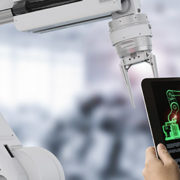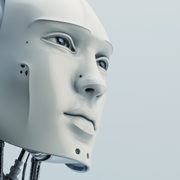4 invaluable benefits of robots in the workplace
Robots in the workplace have created quite the stir. People are afraid their jobs will be taken, and some even fear a full-scale robot takeover.
However, this stir should be redirected into more positive thoughts and feelings.
You see, the benefits of robots in the workplace are invaluable, and they could actually end up creating new opportunities for people of all skill levels.
Here are just a few of the benefits robots in the workplace can offer.
Precision
Perhaps one of the greatest benefits of robots in the workplace is precision. You see, a robot doesn’t get tired; it doesn’t have opinions, and it doesn’t lose its train of thought. It’s focused on one thing and one thing only — the thing it was designed and built to do.
With this high level of precision, companies can expect a product (or at least a component of a product — or in some cases, a component of a task or project) that is 100% consistent. Every time, that product is built exactly the same way — with no deviations and no errors.
Safety
Some jobs are perfectly safe. A person can show up to work every day, sit down at his or her desk, and feel no imminent danger. But this isn’t the case for every worker.
Oftentimes, a person shows up to work and is required to don a set of protective gear, follow a series of safety procedures, and remain very aware of the potential for danger. Robots, however, can eliminate some — if not all — of this risk to human life and limb.
Design, program, and build a robot to handle those dangerous tasks, and a person’s life is no longer in jeopardy. And with the degree of precision a robot is capable of maintaining, it’s very likely the robot itself will never succumb to any harm.
Reliability
When you have a production line, one task hinges on another. If that first task isn’t completed, then that second task can’t be started. Well, what happens if the person responsible for that first task doesn’t show up to work?
In this situation, either production halts for the day or employees are shuffled around. If employees are shuffled around, then it is only natural to assume that productivity and precision of task won’t be as great — you’re having people perform tasks that they aren’t used to performing.
You also have to consider safety. With employees performing tasks they aren’t exactly familiar with, this leaves a degree of vulnerability.
However, robots aren’t like humans. They don’t get sick; they don’t have children, and they don’t have personal responsibilities. That robot will be where it’s supposed to be every day, no matter what. A robot is reliable, and because of this, it indirectly has a positive effect on many different facets of a business.
Jobs
Many people have long hailed robots in the workplace as negative. They fear that robots will one day replace humans, and unemployment rates will skyrocket as a result.
However, this is far from the case.
Robots can’t do everything a human can do, and likewise, consumers don’t want robots to do everything a human can do — in other words, even if a robot can do a human function (like customer service), this doesn’t mean it’s in the best interest of the company to have a robot perform that specific function.
On top of this, robots that perform manual, repetitive tasks can improve the quality of your product and free up manhours. This doesn’t automatically mean that these manhours will be eliminated altogether — it simply means they can be invested into other opportunities for human contribution. Also, with a better-quality product, you may sell more of that product — which equates to a necessary jump in manhours.
And then you also have to consider the robots themselves. The maintenance, management, and production of the robots necessitate more human jobs, as well. While it might not specifically be “more jobs” in the company utilizing those robots, it does equate to more jobs in the companies producing and servicing those robots.
In this case, it’s important to look beyond the obvious and short-term byproduct of robots in the workplace. Consider the long-term impact to see the full gain for businesses willing to enhance their workforce with robotic assistance.
Robots in the workplace don’t always mean an actual, physical robot. Sometimes, a robot can simply be a piece of code, like the ImmyBot (read the article to learn why).









